
Viscount Cobham is a title in the Peerage of Great Britain that was created in 1718. Owing to its special remainder, the title has passed through several families. Since 1889, it has been held by members of the Lyttelton family.

Earl of Donoughmore is a title in the Peerage of Ireland. It is associated with the Hely-Hutchinson family. Paternally of Gaelic Irish descent with the original name of Ó hÉalaighthe, their ancestors had long lived in the County Cork area as allies of the Mac Cárthaigh clan; they lost out during the times of Oliver Cromwell. One branch of the family converted to the Anglican Church and after inheriting territories through his mother and adding "Hutchinson" to Hely, became the Earl of Donoughmore.

Viscount Valentia is a title in the Peerage of Ireland. It has been created twice. The first creation came in 1621 for Henry Power. A year later, his kinsman Sir Francis Annesley, 1st Baronet, was given a "reversionary grant" of the viscountcy, which stated that on Power's death Annesley would be created Viscount Valentia. Annesley, a member of an influential Anglo-Irish family which descended from Newport Pagnell in the County of Buckinghamshire, was a favourite of James I, who granted him land in Ireland, notably the fort of Mountnorris in County Armagh. He was knighted in 1616, created a baronet, of Newport Pagnell in the County of Buckingham, in the Baronetage of Ireland in 1620 and Baron Mountnorris, of Mountnorris in the County of Armagh, in 1628.

Heinrich Graf von Taaffe, 12th Viscount Taaffe was an Austrian landowner who until 1919 held hereditary titles from two different countries: he was a Count (Graf) in the nobility of Austria and a viscount in the Peerage of Ireland.

Earl of Clanricarde is a title that has been created twice in the Peerage of Ireland, first in 1543 and again in 1800. The former creation became extinct in 1916 while the 1800 creation is extant and held by the Marquess of Sligo since 1916.
Feldmarschall Nicholas Taaffe, Graf von Taaffe, 6th Viscount Taaffe and 6th Baron of Ballymote, was an Irish-born courtier and soldier who served the Habsburgs in Lorraine and Austria.

Ballymote is a market town in southern County Sligo, Ireland. It is around 20 km south of Sligo town in the province of Connacht, which is in the north-west of Ireland. Ballymote lies in the barony of Corran. It is a commuter town with a strong history of independent enterprises along with firm local health, school, and transport services. Ballymote is on the main Dublin to Sligo Train Line, and 10 minutes from the N4 / N17 roads. The town serves a large hinterland area in south east County Sligo.

Eduard Franz Joseph Graf von Taaffe, 11th Viscount Taaffe was an Austrian statesman, who served for two terms as Minister-President of Cisleithania, leading cabinets from 1868 to 1870 and 1879 to 1893. He was a scion of the Irish Taaffe noble dynasty, who held hereditary titles from two countries: Imperial Counts (Reichsgrafen) of the Holy Roman Empire and viscounts in the Peerage of Ireland.
The title of Earl of Carlingford was created in the Peerage of Ireland for Theobald Taaffe. The Earl bore the subsidiary titles Viscount Taaffe and Baron of Ballymote (1628).

Thomas Dillon, 4th Viscount DillonPC (Ire) held his title for 42 years that saw Strafford's administration, the Irish Rebellion of 1641, the Irish Confederate Wars and the Cromwellian Conquest of Ireland. He was a royalist and supported Strafford and Ormond. He sided with the Confederates for a while but was a moderate who opposed Rinuccini, the papal nuncio.

Theobald Dillon, 1st Viscount Dillon, was an Irish military commander and adventurer. He held extensive lands in eastern Connacht and north-western Leinster, some acquired by sharp practices. He was a loyal supporter of Elizabeth I of England in her Irish wars.
Theobald Taaffe, 1st Earl of Carlingford, known as 2nd Viscount Taaffe, of Corren and 2nd Baron of Ballymote between 1642 and 1661, was an Irish Royalist officer who played a prominent part in the Wars of the Three Kingdoms. Following the outbreak of the Irish Rebellion of 1641, the Catholic Taaffe remained loyal to the authorities in Dublin. He later joined the Irish Confederates, and was awarded command of the Munster Army. Taaffe was a supporter of the moderate faction, and strongly supported an alliance between the Confederates and Irish Royalists. After the Cromwellian conquest of Ireland, Taaffe accompanied Charles II in exile. Following the Restoration, he was created 1st Earl of Carlingford.
Christopher Plunket, 2nd Earl of Fingall and 11th Baron Killeen was an Irish politician and soldier. In 1641 he negotiated with the rebels on behalf of the Old English of the Pale and pushed them to join the rebellion. He fought for the rebels at the siege of Drogheda. He joined the Confederates and fought in their Leinster army, notably at Dungan's Hill. When the Confederates fused into the Royalist Alliance, he fought under James Butler, 1st Duke of Ormond in the Battle of Rathmines where he was wounded and taken prisoner. He died of his wounds two weeks later in captivity at Dublin Castle.
Francis Taaffe, 3rd Earl of Carlingford, was 4th Viscount Taaffe, of Corren, and 4th Baron of Ballymote and an army commander and politician of Irish descent in the service of Emperor Ferdinand III in the Austrian capital Vienna and later of Duke Charles IV of Lorraine in Nancy.

Butler is the name of a noble family whose members were, for several centuries, prominent in the administration of the Lordship of Ireland and the Kingdom of Ireland. They rose to their highest prominence as Dukes of Ormonde. The family has produced multiple titles such as Baron Cahir, Baron Dunboyne, Viscount Ikerrin, Viscount Galmoye, Viscount Mountgarret, Viscount Thurles, Earl of Carrick, Earl of Kilkenny, Earl of Ormond, Earl of Ossory, Marquess of Ormonde and Duke of Ormonde. Variant spellings of the name include le Boteler and le Botiller. The Butlers were descendants of Anglo-Norman lords who participated in the Norman invasion of Ireland in the 12th century. The surname has its origins in the hereditary office of "Butler (cup-bearer) of Ireland", originating with Theobald Walter, 1st Chief Butler of Ireland. The arms of later family members depicted three cups in recognition of their original office.
Edward Charles Richard Taaffe (1898–1967), known as Richard, was an Irish gemmologist who found the first cut and polished taaffeite in November 1945.
Events from the year 1677 in Ireland.

Corran is a historic barony in south County Sligo in Ireland. It corresponds to the ancient túath of Corann.
Luke Plunket, 3rd Earl of Fingall (1639–1684) was an Irish soldier and politician. He was one of the signatories of the Catholic Remonstrance of 1661.










